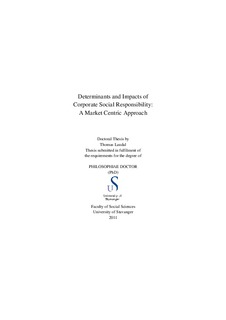| dc.contributor.author | Laudal, Thomas | |
| dc.date.accessioned | 2011-03-25T09:41:55Z | |
| dc.date.available | 2011-03-25T09:41:55Z | |
| dc.date.issued | 2011-03-07 | |
| dc.identifier.citation | Determinants and impacts of Corporate Social Responsibility: a market centric approach / by Thomas Laudal, Stavanger : University of Stavanger, Faculty of Social Sciences, Department of Media, Culture and Social Sciences 2011 (PhD thesis UiS, no. 124) | en_US |
| dc.identifier.isbn | 978-82-7644-446-9 | |
| dc.identifier.issn | 1890-1387 | |
| dc.identifier.uri | http://hdl.handle.net/11250/184954 | |
| dc.description | PhD thesis in Change management | |
| dc.description | This thesis is based on the following papers: (paper 3 and 4 are not in open access) | |
| dc.description | PAPER 1: Laudal, T. (2011) An attempt to determine the CSR potential of the international clothing business. Journal of Business Ethics, 96(1), 63-77. | |
| dc.description | PAPER 2: Laudal, T. (2011).Drivers and barriers of CSR and the size and internationalization of firms. Social Responsibility Journal, 7(2) | |
| dc.description | PAPER 3: Laudal, T. Determinants of a strong CSR impact. A market centric approach. Case: multinational european clothing retail
Submitted to Business and Society Review. | |
| dc.description | PAPER 4: Dissemination of CSR among SMEs in Poor Countries A Qualitative Meta-Synthesis
Thomas Laudal | |
| dc.description | PAPER 5: Rising Externality Costs and Corporate Social Responsibility. Case: EU legislation on Electric and Electronic Equipment - This article is forthcoming in Social Responsibility Journal’. | |
| dc.description.abstract | Aims
The main research aims of this PhD project is to contribute to a better understanding of three themes related to corporate social responsibility (CSR): First, how should we understand CSR by taking into account the core characteristics of the corporation in the market economy? Many academic contributions take the view that economic profitability is one of the social responsibilities of the firm, but few focus on the implications of the firm‟s market position for CSR. Second, how may we establish a link between CSR impact and indicators of sustainable development? It is argued that the dominant model in this area, the “triple bottom line model”, fails to point out important qualitative differences between economic, social and environmental values. Third, how does the interplay between the firm level and the societal level influence CSR? Academic articles on determinants of CSR tend to focus either on the firm level, or on the societal level. This thesis considers if, and how, CSR related features at the societal level may inform our understanding at the firm level and vice versa. In empirical analysis of CSR we consider possible implications for government policies.
Market centric approach to CSR
This thesis contends that we should use a “market centric approach” to better understand why and how firms seek to improve their social and natural environment. The approach is based on Bowman (1973), Sethi (1979), and Crouch (2006). CSR is here understood as efforts to internalize and institutionalize externalities produced by business transactions, prompted by the corporation‟s own business strategies or by government policies. “Internalizing” an externality indicates that a business entity bears all, or part, of the costs related to certain negative externalities, or obtains advantages related to certain positive externalities. “Institutionalizing” an externality indicates that the firm‟s organizational structure and business model is adapted in order to ensure that the externality is internalized over time. CSR performance is seen as a transitional process ending when the externality cost is institutionalized. This approach ensures that firms‟ CSR performance is understood in light of their need to perform as well as, or better, than their competitors. It is argued that this perspective not only considers the “realistic” competitive context of the firm, it also recognizes that firms have unique resources, it capitalizes on insights in economics, it addresses the interests of shareholders, and it suggests that indicators of sustainable development should be used when we measure the impact of business on its social and natural environment. When focusing on the impact on the social and natural environment, we may further distinguish between “first order CSR impact” and “second order CSR impact”. “First order CSR impact” is associated with impacts on the social and natural environment which is measured quantitatively by estimating the effects of externalities on the social and natural environment. “Second order CSR impact” is associated with the systemic impact on the social and natural environment and measured by identifying how “first order CSR impact” influences indicators of sustainable development. The second order CSR impact may also be said to be the impact of increasing entropy (the production process) on systemic conditions for sustainable development.... | en_US |
| dc.language.iso | eng | en_US |
| dc.publisher | University of Stavanger, Norway | en_US |
| dc.relation.ispartofseries | PhD thesis UiS;124 | |
| dc.relation.haspart | Paper 1: Laudal, T. (2011) An attempt to determine the CSR potential of the international clothing business. Journal of Business Ethics, 96(1), 63-77. http://idtjeneste.nb.no/URN:NBN:no-bibsys_brage_18495 | |
| dc.relation.haspart | Paper 2: Laudal, T. (2011).Drivers and barriers of CSR and the size and internationalization of firms. Social Responsibility Journal, 7(2) | |
| dc.relation.haspart | Paper 3: Laudal, T. Determinants of a strong CSR impact. A market centric approach. Case: multinational european clothing retail
Submitted to Business and Society Review. | |
| dc.relation.haspart | Paper 4: Dissemination of CSR among SMEs in Poor Countries A Qualitative Meta-Synthesis
Thomas Laudal | |
| dc.relation.haspart | Paper 5: Rising Externality Costs and Corporate Social Responsibility. Case: EU legislation on Electric and Electronic Equipment (EEE)
Thomas Laudal - This article is forthcoming in Social Responsibility Journal | |
| dc.rights | Copyright the author, all right reserve | |
| dc.title | Determinants and impacts of Corporate Social Responsibility: a market centric approach | en_US |
| dc.type | Doctoral thesis | en_US |
| dc.subject.nsi | VDP::Social science: 200::Economics: 210::Business: 213 | en_US |
| dc.source.pagenumber | 113 p. | en_US |
